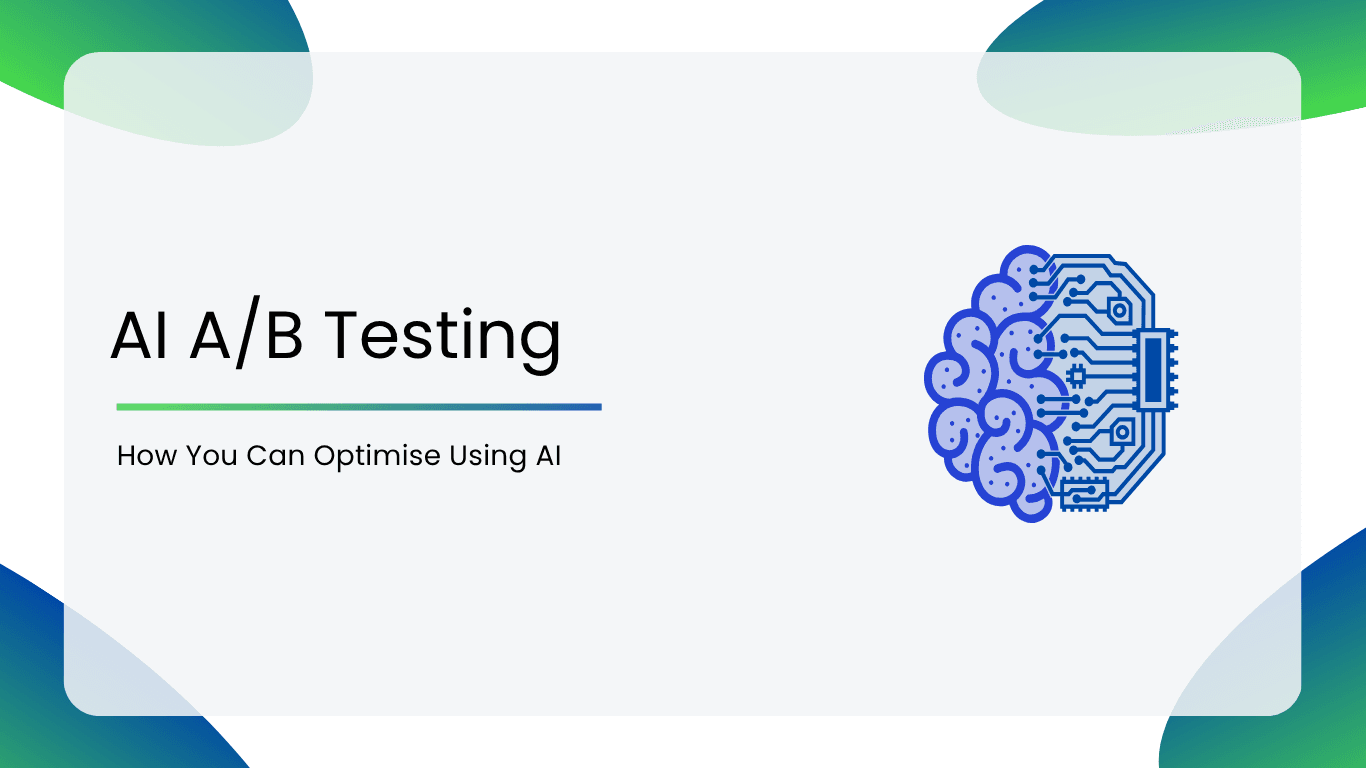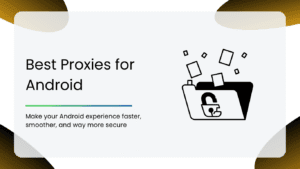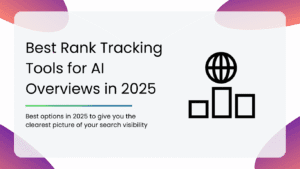Did you know that AI-powered A/B testing can boost your conversions by up to 30% faster than traditional methods? If you’re still running manual tests, you’re risking falling behind competitors!
Now, if you’ve ever wondered whether adjusting a headline, button colour, or image on your site might drive more conversions, you’re not the only one, and likely already aware of A/B testing. This tried-and-true approach is a testing methodology that compares two versions of an element, such as Version A and Version B, in order to identify which version performs better.
But hold on, there’s a catch: regular A/B testing is slow, limiting, and time-consuming. And that is exactly where AI steps in and turns the whole scenario around.
A/B testing with AI is not just a simple comparison; it learns, forecasts, and improves. Based on machine learning powers, AI A/B testing speeds up the decision-making process, tries unlimited variations simultaneously, and also improves in real time as per the user’s behaviour.
In this post, we will explore how AI takes traditional testing to the next level and how you can use it to continuously optimise your product and marketing choices.
Limitations of Traditional A/B Testing
- It Takes Time to Get Results: Traditional A/B testing requires a large number of users and several days or even weeks to gather data that are statistically significant. For businesses that aim to move fast, this delay can be a major drawback.
- You Can Only Test One Change at a Time: If you want to test multiple elements on a page, like a headline, image, and CTA, you need to run separate tests or risk mixing up the results. This makes optimisation a slow and step-by-step process.
- Results are Static, Not Evolving: Once a test is done, it doesn’t continue the learning process. If user behaviour changes over time-seasonally, or due to the test, it won’t adapt unless you manually run it again.
- Requires a Large Sample Size: Smaller businesses or niche markets might struggle to get enough traffic in order to perform reliable testing. Without statistical confidence, your last results might be misleading.
- Lack of Personalisation: Traditional A/B testing treats all users the same. It doesn’t account for different audience segments or personalise experiences, which results in missing opportunities for deeper engagement.
Comparison Table: Traditional vs. AI A/B Testing
| Feature | Traditional A/B Testing | AI-Powered A/B Testing |
| Speed of Results | Slow (days/weeks) | More rapid with fewer risks |
| Personalization | Limited (one-size-fits-all) | Dynamic per-user segment |
| Multivariate Testing | Manual, limited combinations | Automated & tests 100s of variants |
| Sample Size Needed | Large (for statistical significance) | Works even with smaller traffic |
How AI Transforms A/B Testing
- Predictive Analytics: AI uses historical data and machine learning to predict which variation will perform the best. This helps marketers make decisions that are smarter, even before the test fully runs.
- Dynamic Adaptation: Unlike traditional methods, AI can adjust test parameters in real time based on user behaviour. This results in automatically favouring the better-performing version as and when the data comes in.
- Multivariate Testing at Scale: AI enables simultaneous testing of multiple variables like CTA, images, and layout without confusing results. This helps teams optimise complex user journeys faster.
- Personalisation and Segmentation: AI can segment audiences automatically and serve personalised versions of content to different user groups. This helps in increasing overall engagement and conversions.
- Continuous Learning: Instead of ending after one test, AI systems continuously learn and optimise. This helps in refining results as more user data flows in.
Key KPIs to Measure AI-Driven A/B Testing
- Conversion Rate: Measures how effectively a variation leads users to take the desired action.
- Click-Through Rate (CTR): Tracks how engaging your variations are to the users.
- Engagement Time: Shows how long users interact with your content.
- Bounce Rate: Helps to understand if a version is turning users away too quickly.
- Return on Investment (ROI): Ties performance directly to revenue and costs.
- Test Duration: With AI, faster insights mean reduced test time.
How to Use AI in A/B Testing
Step 1: Define Your Goal Clearly
Before you begin any test, whether it is AI-powered or not, you need to decide what success looks like to you. Is it increasing sign-ups? Boosting purchases? Improving engagement? AI tools need very clear objectives to optimise toward the right outcome.
Step 2: Choose the Right AI Testing Tool
There are several platforms that offer AI-based experimentation, like Google Optimise, Adobe Target, VWO, or Optimizely. Choose a tool based on your traffic size, tech stack, and goals. Many tools now offer built-in AI features such as automatic winner selection, personalisation, and predictive analysis.
Step 3: Set Up Multiple Variants
Unlike traditional A/B testing, which compares only two versions, AI allows for multivariate testing. You can test multiple headlines, CTAs, colours, and layouts simultaneously, and the AI will identify the best-performing combinations over time.
Step 4: Let AI Take Control of Traffic Distribution
AI doesn’t just split traffic 50/50. It dynamically adjusts traffic in real-time, which helps in sending more visitors to the winning variation as soon as trends emerge. This results in minimised wasted time and reduces conversion loss that happens during the testing period.
Step 5: Analyse Insights and Keep Learning
The beauty of AI is that it offers more than just results; it offers actionable insights. Make use of what you learn to improve future campaigns. Better yet, allow the AI to continuously learn and adapt, so that your platform stays optimised even as user behaviour changes.
30-day AI Testing Implementation Plan
This is an AI-generated image (ChatGPT). Prompt used – Infographic showing AI testing implementation plan with the following information: add info, in a minimalist style.
Real-World Applications of AI A/B Testing
AI A/B testing isn’t just a concept for data scientists; it is something that is being used every day by some of the biggest brands in the world to improve user experience, drive conversions, and create personalised digital journeys.
Let’s explore how companies across various industries are putting AI-driven testing into action, often without you even realising it.
1. Amazon: Smarter Shopping Experiences, Powered by AI
Whenever you’re browsing Amazon, you suddenly see just the right product with a “limited-time deal” tag or the perfect suggestion in your feed. If you think it’s a coincidence, it’s not – it’s AI doing its magic.
Amazon uses AI A/B testing to experiment with everything from product recommendations to pricing layouts. Instead of waiting days or weeks to evaluate what works and what doesn’t, AI tests and adapts results on the go. If a certain layout works better for mobile users and a different one for desktop users, AI figures that out in real time and adjusts according to that.
Why it matters: This dynamic experimentation helps Amazon provide a faster, more personalised experience for millions of shoppers across the globe that ultimately helps in boosting both satisfaction and sales.
2. Netflix: The Power of the Perfect Thumbnail
Ever noticed how the cover image for a show on Netflix changes to something that you end up clicking? This is again done using AI.
Netflix runs AI-powered A/B tests on thumbnails to see which one catches your eye. Different user might see completely different artwork for the same show, which depends on what they’re likely to click based on their past behaviour.
For example, if you are someone who watches a lot of romantic comedies, you might see a smiling couple on the poster, while someone who loves drama might see a more intense scene from the same series.
Why it matters: This helps Netflix drive more clicks and get longer watch times. And all of this without changing the actual content, just how it’s presented.
3. Google Ads: Smarter Campaigns That Learn As They Run
When businesses run ads on Google, they can use Smart Campaigns, which are powered by machine learning. Instead of testing one or two headlines manually, Google’s AI tests hundreds of combinations of headlines, descriptions, and CTAs across different audiences.
The AI quickly learns which version gets the most clicks, conversions, or even sign-ups and continuously keeps adapting the ads in real time to maximise performance.
Why it matters: This highly reduces the need for constant manual optimisation and helps small businesses get better results with fewer resources.
4. Booking.com: Experiments in the Thousands
Booking.com is famous for its culture of experimentation. They reportedly run over 1,000 A/B tests at any given time. With the help of AI, these tests don’t just compare two versions anymore.
Their platform can automatically customise what users see based on their location, travel behaviour, and even the time of year. AI helps determine what layout, filter order, or call-to-action works best for each user segment.
Why it matters: Travellers get a smoother and booking experience that is more relevant to them. This helps booking.com to increase its chances of converting visitors into customers.
The Future: AI + A/B Testing
AI is not just enhancing A/B testing–it’s redefining it. Here’s what the future looks like:
- Real-Time Personalisation at Scale: AI will deliver different versions of a website or app to individual users based on preferences, behaviour, and device. This will turn A/B testing into A-to-Z personalisation.
- Predictive Experimentation: Before a single test even starts, AI will be able to predict which version is likely to win by using historical and behavioural data. This will reduce the need for trial and error.
- Voice & Visual Testing: With the rise of voice search and visual commerce, AI will help run experiments on non-text interfaces, such as voice commands, product images, or even AR content.
- Zero-code Testing for Teams: No more relying on developers. AI-driven platforms will offer intuitive, drag-and-drop tools that will let marketers and designers test ideas instantly, without even touching code.
- Continuous Learning Systems: Instead of isolated tests, AI will create always-on testing environments that will constantly optimise and adapt based on real-time user interactions.
Conclusion
AI is revolutionising A/B testing from a slow and manual process to a quick, intelligent one that looks, learns, and adjusts in real-time. It doesn’t simply inform you what’s working–it informs you who it’s working for and why, so your marketing is wiser and more precise.
With the advent of affordable AI solutions, any-sized organisations can carry out more effective, data-driven tests.
As consumer behaviour evolves at a lightning speed, relying on guesswork or outdated testing methods is a risk that you cannot afford. The future belongs to brands that adapt themself instantly, personalise at scale, and let the AI do the heavy lifting.
The verdict is clear: AI-driven A/B testing isn’t just an upgrade – it’s the new industry standard. Embrace it now, or risk falling behind.
If you’re curious about how AI is transforming other creative fields, check out the links below for more insights!
- Top AI Tools For Influencer Marketing
- Best AI Interior Design Tools in 2025
- Best AI Keyword Research Tools in 2025
FAQs
Yes! AI helps compensate for low traffic by predicting trends faster.
Yes, but focus on micro-conversions & Bayesian statistics to get results with smaller samples.
AI can detect winners 2–5x faster than manual tests.
Data integration (e.g., connecting CRM/payment systems).





